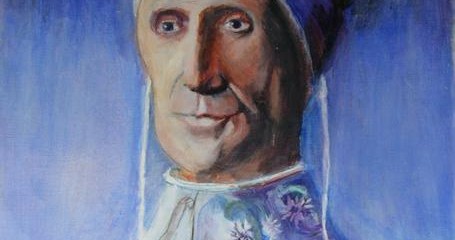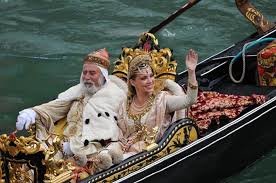Doges were the heads of the Republic for over a thousand years. The name of the Doge (Dose in the Venetian language ) takes place between the ninth and tenth century.
The qualification of the Doge is that of the most serene prince, ranking just below the Pope, the Emperor and King, but superior to all principles of the royal line although in public acts is called “Monsignor the Doge”. Actually he reigns, did not govern.The Doge is the vortex of the constitution of the republic. And the symbol of power and splendor of the Serenissima.
The ceremonies of the Doges of Venice
The coronation of the new doge was from a unparalleled vivacity. The newly elected was accompanied by the six great wise men ( -i sapientes- representing the Permanent Council of the Doge). Among the salvos of artillery and sounds of huts he went to the Ducal Palace, then to San Marco, where, ascended the rostrum of marble that was
to the right of the choir showed himself to the people.
After the mass, sworn loyalty, and received the banner with the winged lion. Then coated with the ducal mantle was carried by workers of Arsenal, around Piazza San Marco,throwing pieces of silver and gold to the crowd.
Returned to the Palazzo Ducale, from top of the ladder, between the two statues, Neptune and Mars and under the winged lion,took place the solemn ceremony of coronation . During the coronation, the new Doge received the “Zoia”, the ducal cap, from the hands of senior adviser after swearing allegiance to the state laws.
In ceremonies before him were the sword, the chair of golden fabric and the parasol. At his side are sitting the great captain and his lackeys, the chancellor with his secretaries and behind him are in hierarchical order the members of the Signoria, the Ten, the Municipal Avocati, prosecutors, the Senate.
Dressing :
Large purple robe (later brocarto gold) lined and trimmed with ermine ,red shoes of the Byzantine emperors. The gold crown is replaced in the fourteenth century by a headgear called “doge’s horn”. Has its own ship called Bucintoro.
His rights are few: Assign the Patriarch of Venice, the canons of San Marco, and
introduces to the Great Council “proposals” to be discussed with priority.
Is incessantly controlled by his advisers, he is not participating to the deliberations of wise men, to the Senate.
His vote has no more value than anyone senator. In matters of foreign policy, the Doge could not decide peace or war, make treaties, send or receive embassies, without the help of the wise men who formed his council.
He is the servant of his electors and aristocracy . He had no more real power than the right to conduct wartime military operations and command the fleet.
The Doge was the most supervised and the most obedient servant of the Serenissima.
It would be very difficult to remember all the hundred and twenty doges of Venice. Although all are important for the history of Venice, here are some doges of Venice with their characteristics:
The first Doge of Venice was Paulicio Anafesto (697-717).
Peter Tradonico (836 -864) could not read and write, so the documents and edicts were signed with “Signum magnus”
Peter I Candiano (887)
with the shortest charge, six months. He was killed in a reprisal against pirates “Neretva” (actual Croatia).
Peter Orsello II (991-1009) – opens the way of the naval market, regaining Bari and Taranto from the hands of the Saracens. The republic was recognized by the Papal State.
Ottone Orselo (1009-1026) was elected doge when he had 15 years old.
Faldero (Ordelaf) Falier Dodoni (1102-1118)
Reconquest Zara and proclaimed king of Hungary and Croatia.
Enrico Dandolo, became Doge of Venice at seventy years (January 1193) when he was already old and blind.Dandolo proved ‘incredible physical and mental strength for his age
. http://www.loccidentale.it/node/53855
Marin Faliero at age 60 years became doge (11 September 1354), and April 17, 1355 was beheaded for having conspired against the Republic.
http://dipoco.altervista.org/doge-venezia-marin-faliero/
Francesco Foscari was one of the most popular but also the most hated Doge in the history of Venice.Passes into history as the longest Dogato 1423 -1457.
http://scrignodeltempo.blogspot.it/2013/01/francesco-foscaridoge-di-venezia.html
Sebastiano Venier, amiraglio, winner of Lepanto (1571) against the Turks, was elected doge age 81.
http://venipedia.it/personalit%C3%A0/dogi/venier-sebastiano
The doges Bertucci (1656-1658 father) and Sylvester (1694-1700-son) Valier.
These had a single vice: gambling, often attending the casino’s Ridotto.
Francesco Corner elected on May 17, 1656 aged 71, died June 5 of that year. Is the record of the shortest leading in the history of the Venice Republic.
Francesco Loredan (1752-1765) start to get sick in 1755, at seventy. The agony lasted seven years and no means surgical or other devilish known was unable to cure him.
In the “Pantheon of the Doges of Venice“,
http://dipoco.altervista.org/venezia-san-giovanni-paolo/
were buried, begining with the year 1200, twenty-five of one hundred and twenty of the Doges of the Republic.
The basilica Saints John and Paul (called San Zanipolo in Venetian dialect) is one of the most impressive religious medieval buildings of Venice.
On the death of the Doge, the eldest of the adviser said:
“With great sorrow we have heard about the death of Serene Prince of so much goodness and mercy.
But we’ll make another. ”
The death was announced to the entire city by the sound twice for nine times of church bells.
The doge was immediately embalmed and wrapped in the mantle of gold, with the doge’s horn on his head,the golden spurs shod with the upside down and the sword of command with the handle towards the legs. On the third day after his death, took place funerals,in a procession attended by thousands of people.
From the church, after the funeral oration, they all leaving in gondola.
The folk did not participate to the funeral of the doge, perhaps because according to an ancient prophecy, the church would have collapsed on the day of a solemn celebration.
Ludovico Manin 1789-1797 last venetian doge.
After his election Pietro Gardenigo said : They proclaimed a Friulian doge. The republic is died. On May 12, 1797, surrounded by the French army, without resistance, the Doge deposed the ducal insignia.
The abdication was made in favor of a Provisional Municipality. On May 16, the treaty was signed for submission to the French republic,led by Napoleon Bonaparte
other items: http://dipoco.altervista.org/see-other-items/






